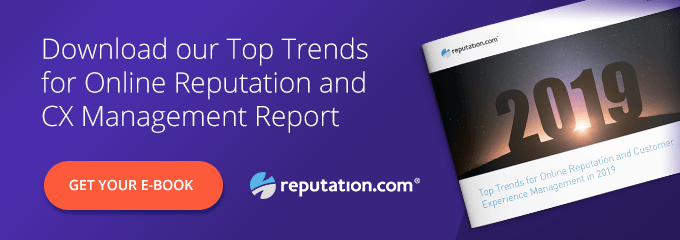Top Customer Survey Best Practices for 2019
Reputation Staff Writer

Effective surveys are the ones that get responses, ask the right questions for the task, are distributed so people can find and complete them conveniently, and produce actionable data and insights. Follow these survey best practices for 2019 to address all of these key aspects of successful customer surveys.
Make Surveys Engaging, Relevant and Useful
Just as you plan and design a blog post, infographic or customer whitepaper to be eye-catching and compelling, so must you design customer surveys. Competition for consumer attention is stiff, and surveys that don’t capture consumers’ attention immediately are likely to be passed over. Not only must the content of the customer survey be carefully researched and well worded, the “look and feel” of the survey must be inviting.

Surveys that are disorganized, dull, overly long or unattractive won’t get good response rates.
Keep Surveys Brief
To gather customer feedback from the mainstream of the pool you’re surveying, you have to keep the survey length reasonable. Yes, some people do have the time and motivation to respond to lengthy surveys, but in most cases, those people are not representative of the population whose feedback you need. Likewise, keep the number of rating choices on “scale” questions small. In other words, a 1 to 5 scale is more consumer-friendly than a 1 to 10 scale.
Avoid Intrusive, Difficult or Unnecessary Questions
Most customer surveys do not need to know the respondent’s age or income. People are increasingly protective of their online privacy, and even with reassurances that you protect consumer data, they won’t be keen to answer invasive questions. If you must ask such questions, make customer responses optional. Otherwise, you will reduce your response rate and the quality of your survey data.
Ask for an Overall Rating First

Initial overall ratings offer tremendous value, because they haven’t yet been influenced by survey questions.
By asking for an overall rating first, you get a fresh response that has not been overly influenced by a series of more detailed questions. Once a survey respondent has answered, say, a dozen detailed questions, their rating is likely to take into account everything they have just answered. Knowing what their “top of the head” rating is up front gives you honesty, and follow-up questions will flesh out that overall rating.
Include Binary and Multiple-Choice Questions for Simplicity
Binary (yes-no) questions are simple and encourage survey responders to continue. Multiple choice questions offer a bit more granularity by offering three or four mutually exclusive choices. Binary questions can be great for building simple knowledge bases that can help with important tasks like optimizing web page content, while multiple-choice questions are useful for segmenting data based on a handful of important categorical variables. Even with these simple question types, however, it’s important that you avoid overloading respondents with too many questions.
Use Scale Questions to Segment Data and Follow Data Longitudinally
Scale questions (such as, “How satisfied were you, on a scale of 1 to 5?”) are standardized, and people are used to answering them. You gain more data granularity than you can with binary or multiple-choice questions, and you can use scale questions repeatedly over time to understand longitudinal trends. Of course, you can use binary and multiple-choice questions repeatedly, but you won’t gain the same degree of insight into trends as you do with scale questions.
Use Open-Ended Questions to Tie Up Loose Ends

Qualitative data captured in answers to open-ended questions clarify data collected in quantitative survey questions.
Don’t discount the importance of qualitative customer feedback. It gives you insights you won’t get from quantitative survey questions, and helps answer “why” questions. For example, if a person gives low satisfaction scores on quantitative questions, they are likely to expand on their reasons for doing so by answering open-ended questions. Open-ended questions let you know what is important to customers, and why.
Know the Value of Surveys Timed at Different Customer Phases
Customer feedback evolves over time, and sending out customer surveys at different phases of the customer journey delivers richer insights. Presenting a survey immediately after a purchase or a customer service interaction answers one category of key questions. Presenting surveys later on in the customer experience timeline answers others. Multiple surveys, sent out strategically, help you catch problems at different stages of customer experience and act on them promptly.
Offer Surveys Across Multiple Platforms
Your surveys must be functional and eye-pleasing regardless of the device a customer uses to answer them. If you only send out traditional web surveys, you risk alienating the large numbers of people whose primary devices are tablets and phones. Bear in mind that because so many people complete surveys on mobile devices, survey design should minimize the amount of text typing required and maximize the use of single-tap responses.
Keep Survey Fundamentals Constant for Long-Term Comparison

Issuing the same survey at selected intervals can help you understand long-term trends.
Designing surveys well up front is more important than many brands realize. Surveys you used at multiple intervals over the span of your relationship with customers must be absolutely consistent, or you risk collecting data that becomes meaningless in aggregate. Make sure introductory language, mode of delivery, length of time you allow for response and questions/choices are consistent, so you can be confident in the longitudinal data you collect.
Use Deep Analytics for Actionable Insights
Ultimately, you want actionable insights from customer survey data, and today you have access to deep analytics to deliver those insights. By analyzing segmented feedback across multiple customer attributes, you can perform competitive benchmarking and measure and compare performance of your locations. Reputation.com offers both survey-building tools and analytics to help you see exactly how your reputation and customer sentiment changes, and how you perform against industry benchmarks.
Sales figures will always be important, but without customer feedback, you simply cannot know why customers act as they do. Learning how to design, deliver and analyze customer surveys is one of the most important tasks any business can undertake, because of the tremendous potential for understanding customers and addressing their needs.
It is only when you have trusted, actionable insights based on customer feedback that you can deliver the exceptional customer experience that elevates your brand above all others. If you’re ready to get started, Reputation.com invites you to download our free 5-Step Guide to Improving Your Online Reputation.


